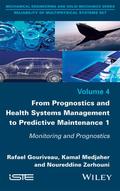From Prognostics and Health Systems Management to Predictive Maintenance 1
Monitoring and Prognostics

1. Edition November 2016
182 Pages, Hardcover
Wiley & Sons Ltd
This book addresses the steps needed to monitor health assessment systems and the anticipation of their failures: choice and location of sensors, data acquisition and processing, health assessment and prediction of the duration of residual useful life. The digital revolution and mechatronics foreshadowed the advent of the 4.0 industry where equipment has the ability to communicate. The ubiquity of sensors (300,000 sensors in the new generations of aircraft) produces a flood of data requiring us to give meaning to information and leads to the need for efficient processing and a relevant interpretation. The process of traceability and capitalization of data is a key element in the context of the evolution of the maintenance towards predictive strategies.
Chapter 1. PHM and Predictive Maintenance 1
1.1. Anticipative maintenance and prognostics 1
1.1.1. New challenges and evolution of the maintenance function 1
1.1.2. Towards an anticipation of failure mechanisms 3
1.2. Prognostics and estimation of the remaining useful life (RUL) 5
1.2.1. What is it? Definition and measures of prognostics 5
1.2.2. How? Prognostic approaches 6
1.3. From data to decisions: the PHM process 9
1.3.1. Detection, diagnostics and prognostics 9
1.3.2. CBM Architecture and PHM process 10
1.4. Scope of the book 12
Chapter 2. Acquisition: From System to Data 15
2.1. Motivation and content 15
2.2. Critical components and physical parameters 16
2.2.1. Choice of critical components - general approach 16
2.2.2. Dependability analysis of the system and related tools 17
2.2.3. Physical parameters to be observed 19
2.3. Data acquisition and storage 20
2.3.1. Choice of sensors 22
2.3.2. Data acquisition 23
2.3.3. Preprocessing and data storage 24
2.4. Case study: toward the PHM of bearings 25
2.4.1. From the "train" system to the critical component "bearing" 25
2.4.2. Experimental platform Pronostia 26
2.4.3. Examples of obtained signals 30
2.5. Partial synthesis 30
Chapter 3. Processing: From Data to Health Indicators 33
3.1. Motivation and content 33
3.2. Feature extraction 35
3.2.1. Mapping approaches 35
3.2.2. Temporal and frequency features 36
3.2.3. Time-frequency features 38
3.3. Feature reduction/selection 48
3.3.1. Reduction of the feature space 48
3.3.2. Feature selection . 54
3.4. Construction of health indicators 62
3.4.1. An approach based on the Hilbert-Huang transform 62
3.4.2. Approach description and illustrative elements 62
3.5. Partial synthesis 63
Chapter 4. Health Assessment, Prognostics and Remaining Useful Life - Part A 67
4.1. Motivation and content 67
4.2. Features prediction by means of connectionist networks 69
4.2.1. Long-term connectionist predictive systems 69
4.2.2. Prediction by means of "fast" neural networks 77
4.2.3. Applications in PHM problems and discussion 84
4.3. Classification of states and RUL estimation 88
4.3.1. Health state assessment without a priori information about the data 88
4.3.2. Toward increased performances: S-MEFC algorithm 93
4.3.3. Dynamic thresholding procedure 95
4.4. Application and discussion 97
4.4.1. Tests data and protocol 97
4.4.2. Illustration of the dynamic thresholding procedure 101
4.4.3. Performances of the approach 104
4.5. Partial synthesis 105
Chapter 5. Health Assessment, Prognostics, and Remaining Useful Life - Part B 109
5.1. Motivation and object 109
5.2. Modeling and estimation of the health state 111
5.2.1. Fundamentals: the Hidden Markov Models (HMM) 111
5.2.2. Extension: mixture of Gaussians HMMs 117
5.2.3. State estimation by means of Dynamic Bayesian Networks 118
5.3. Behavior prediction and RUL estimation 124
5.3.1. Approach: Prognostics by means of DBNs 124
5.3.2. Learning of state sequences 124
5.3.3. Health state detection and RUL estimation 126
5.4. Application and discussion 129
5.4.1. Data and protocol of the tests 129
5.4.2. Health state identification 131
5.4.3. RUL estimation 133
5.5. Partial synthesis 135
Conclusion and Open Issues 137
Bibliography 143
Index 163
Kamal Medjaher, Associate Professor with the National Institute in Mechanics and Microtechnologies, Besançon, France


